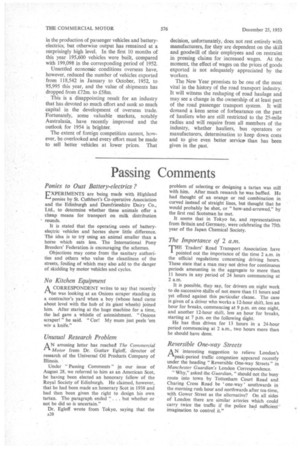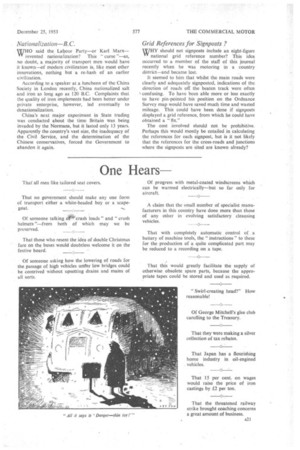Passing Comments
Page 22

Page 23

If you've noticed an error in this article please click here to report it so we can fix it.
Ponies to Oust Battery-eleetrics ?
EXPERIMENTS are being made with Highland ponies by St. Cuthbert's Co-operative Association and the Edinburgh and Dumfriesshire Dairy Co., Ltd., to determine whether these animals offer a cheap means for transport on milk distribution rounds.
It is stated that the operating costs of batteryelectric vehicles and horses show little difference. The idea is to try using an animal smaller than a horse which eats less. The International Pony Breeders' Federation-is encouraging the schemes.
Objections may come from the sanitary authorities and others who value the cleanliness of the streets, fouling of which may also add to the danger of skidding by motor vehicles and cycles.
No Kitchen Equipment
ACORRESPONDENT writes to say that recently he was looking at an Onions scraper standing in a contractor's yard when a boy (whose head came about level with the hub of its giant wheels) joined him. After staring at the huge machine for a time, the lad gave a whistle of astonishment. "Onions scraper!" he said. " Cor! My mum just peels 'em wiv a knife."
Unusual Research Problem
AN amusing letter has reached The Commercial "Motor from Dr. Gustav Egloff, director of research of the Universal Oil Products Company of Under "Passing Comments" in our issue of August 28, we referred to him as an American Scot, he having been elected an honorary fellow of the Royal Society Of Edinburgh. He claimed, however, that he had been made an honorary Scot in 1938 and had then been given the right to design his own tartan. The paragraph ended " . . . but whether or not he did so is uncertain."
Dr. Egloff wrote from Tokyo, saying that the problem of selecting or designing a tartan was still with him. After much research he was baffled. He had thought of an orange or red combination in curved instead of straight lines, but thought that he would probably be shot, or " bow-and-arrowed," by the first real Scotsman he met.
It seems that in Tokyo he, and representatives from Britain and Germany, were celebrating the 75th year of the Japan Chemical Society.
The Importance of 2 a.m.
rfHE Traders' Road Transport Association have pointed out the importance of the time 2 a.m. in the official regulations concerning driving hours. These state that a man may not drive for continuous periods amounting in the aggregate to more than 11 hours in any period of 24 hours commencing at 2 a.m.
It is possible, they say, for drivers on night work to do successive shifts of not more than 11 hours and yet offend against this particular clause.. The case is given of a driver who works a 12-hour shift, less an hour for breaks, commencing at 9 p.m. on one night, and another 12-hour shift, less an hour for breaks, starting at 7 p.m. on the following tiight.
He has thus driven for 13 hours in a 24-hour period commencing at 2 a.m., two hours more than he should have done.
Reversible One-way Streets
A N interesting suggestion to relieve London's "peak-period traffic congestion appeared recently under the heading " Reversible One-way Streets" in Manchester Guardian's London Correspondence. • "Why," asked the Guardian," should not the busy route into town by Tottenham Court Road and Charing Cross Road be 'one-way' southwards in the morning rush hour and northwards after tea-time, with Gower Street as the alternative? On all sides of London there are similar arteries which could carry twice the traffic if the police had sufficient imagination to control it."
Nationalization—B.C.
WHO said the. Labour Party—or Karl Marx" invented nationalization? This "curse "—as, no doubt, a majority of transport men would have it Icnown—of modern civilization is, like most other innovations, nothing but a re-hash of an earlier According to a speaker at a luncheon of the China Society in London recently, China nationalized salt and iron as long ago as 120 B.C. Complaints that the quality of iron implements had been better under private enterprise, however, led eventually to denationalization.
China's next major experiment in State trading was conducted about the time Britain was being invaded by the Normans, but it lasted only 13 years. Apparently the country's vast size, the inadequacy of the Civil Service, and the determination of the Chinese conservatives, forced the Government to abandon it again.
Grid References for Signposts .?
WHY should not signposts include an eight-figure " national grid reference number? This idea occurred to a member of the staff of this journal recently when he was motoring ii a country district—and became lost.
It seemed to him that whilst the main roads were clearly and adequately signposted, indications of the direction of roads off the beaten track were often = confusing. To have been able more or less exactly to have pin-pointed his position on the Ordnance Survey map would have saved much time and wasted mileage. This could have been done if signposts displayed a grid reference, from which he could have obtained a "fix."
The cost .involved should not be prohibitive. Perhaps this would mostly be entailed in calculating the references for each signpost, but is it not likely that the references for the cross-roads and junctions where the signposts are sited are known already?












































































